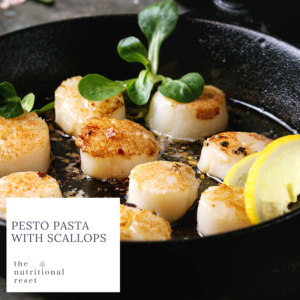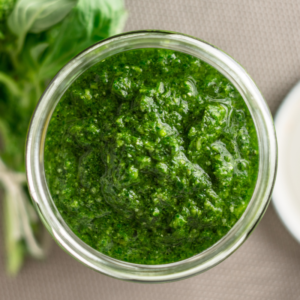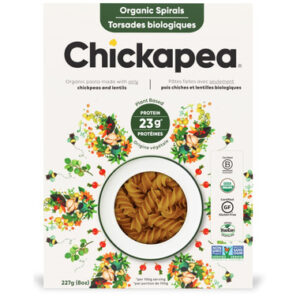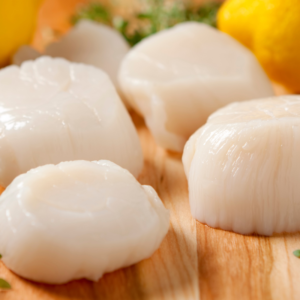 Feeling ravenous and want dinner presto pronto? Then this recipe for Pesto Pasta with Scallops is for you! If seafood just isn’t your thing, you could certainly substitute chicken, although it will be a little less presto pronto (given chicken takes longer to cook). The recipe calls for chickpea pasta which is much higher in protein than regular pasta. So vegetarians can simply omit animal protein altogether and add extra veggies to the pasta and pesto to boost flavour. Cannellini or navy beans work well too.
Feeling ravenous and want dinner presto pronto? Then this recipe for Pesto Pasta with Scallops is for you! If seafood just isn’t your thing, you could certainly substitute chicken, although it will be a little less presto pronto (given chicken takes longer to cook). The recipe calls for chickpea pasta which is much higher in protein than regular pasta. So vegetarians can simply omit animal protein altogether and add extra veggies to the pasta and pesto to boost flavour. Cannellini or navy beans work well too.
Pesto is my saviour when it comes to getting a tasty meal on the table in a timely manner with minimal fuss and muss. You can make your own and keep it in the freezer, ready to thaw as needed. Or make your life even easier and purchase a high-quality pesto from your local market. There are so many varieties out there that you can make this with a different pesto every time to change up the flavour profile. So it’s never boring. And I love that this recipe serves three, making enough for my husband I for dinner and leftovers for my lunch the next day.
Sign up to my newsletter today to receive the recipe for Pesto Pasta with Scallops. And read on for more about:
- my favourite pesto varieties, including a nut-free basil pesto you can make yourself
- why I highly recommend you try chickpea pasta, and
- the nutritional benefits of scallops.
Pesto…makes delicious meals presto pronto
 Whenever I’m pressed for time but still want a healthy meal, out comes the pesto. Either one I’ve made and frozen, or one I’ve purchased. They can be thawed and re-frozen multiple times as long as you thaw them only in the refrigerator. There are so many versions of pesto that, depending on which you use, this recipe can take on a whole different character.
Whenever I’m pressed for time but still want a healthy meal, out comes the pesto. Either one I’ve made and frozen, or one I’ve purchased. They can be thawed and re-frozen multiple times as long as you thaw them only in the refrigerator. There are so many versions of pesto that, depending on which you use, this recipe can take on a whole different character.
I often purchase the Sunflower Kitchen Pestos as they are high quality and readily available where I shop. They offer several varieties including:
- Basil Pesto (their take on the classic)
- Zest-Oh Cilantro pesto (which has a nice spicy kick)
- Kale & Oregano Pesto, and
- Sundried Tomato & Olive Pesto.
Any of these would work well here and they are all dairy-free and nut-free, for those who have allergies/sensitivities. If you don’t, and would prefer a more classic version, here is a recipe for Garlic-Free Pesto. And I encourage you to go ahead and add garlic to this if raw garlic agrees with you. To be totally authentic, use pine nuts in place of the almonds called for in the recipe.
Chickpea pasta … more nutritional bang for your buck
 Of course you could make this recipe with traditional durum wheat pasta. Or whole grain pasta. But if you’ve never had chickpea pasta, I encourage you to give it a try. I like the Chickapea brand (pictured at right). It contains nothing but organic chickpea flour and yellow and red lentil flour. Consider this comparison between 100 grams each of Chickapea rotini versus Barilla rotini:
Of course you could make this recipe with traditional durum wheat pasta. Or whole grain pasta. But if you’ve never had chickpea pasta, I encourage you to give it a try. I like the Chickapea brand (pictured at right). It contains nothing but organic chickpea flour and yellow and red lentil flour. Consider this comparison between 100 grams each of Chickapea rotini versus Barilla rotini:
- Chickapea provides 23 grams of protein and 11 grams of fibre, versus only 12.5 grams of protein and 3.6 grams of fibre for Barilla.
- Chickapea pasta provides 19%, 32% and 32% of the recommended daily values for magnesium, phosphorous and zinc. Barilla rotini is not a significant source of any of these important minerals. And Chickapea rotini contains almost twice as much iron.
So Chickapea rotini definitely offers more nutritional bang for your pasta buck. And all for 7 fewer calories.
Scallops…a super source of selenium
 Scallops often get overlooked but they are an excellent source of lean protein. And it is important to ensure we are consuming sufficient protein as we age. Between the high-protein chickpea pasta and the scallops, this recipe is a protein powerhouse at 43 grams per serving. Scallops are also an excellent source of selenium and one serving of this recipe provides 36% of the recommended daily value. Selenium is critical to proper thyroid function, helping to keep our metabolism humming along. To safely cook scallops, be sure that you heat to an internal temperature of 63 degrees Celsius (145 degrees Fahrenheit). Enjoy!
Scallops often get overlooked but they are an excellent source of lean protein. And it is important to ensure we are consuming sufficient protein as we age. Between the high-protein chickpea pasta and the scallops, this recipe is a protein powerhouse at 43 grams per serving. Scallops are also an excellent source of selenium and one serving of this recipe provides 36% of the recommended daily value. Selenium is critical to proper thyroid function, helping to keep our metabolism humming along. To safely cook scallops, be sure that you heat to an internal temperature of 63 degrees Celsius (145 degrees Fahrenheit). Enjoy!